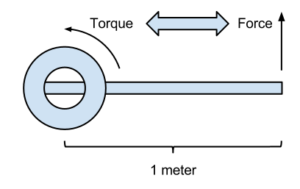Table of Contents
Introduction:
Today we are going to discuss about TORQUE. An unconfined force applied through the center of gravity makes an object move in pure translation according to Newton’s Laws of Motion. If the object is confined at a pivot, the force is transmitted through the pivot and causes the object to rotate, not translate.
If an unconfined object has a force applied at some distance from the center of gravity, then the object will both translate and rotate around the center of gravity. The properties of the rotation depending on the distance from the applied force to the center of gravity.
The information about torque from various physics-related articles is available here. Torque and Its type are important topics in physics. Students who want to flourish in physics need to be well known about torque to get deep knowledge about it to do well on their exams and it is very much useful in real life. The examples, types, measurements, and applications of torque are provided here to assist students in effectively understanding the respective topic. Continue to visit our website for additional physics help.
Overview:
The movement of flying objects is described by this third type of motion; a combination of translation and rotation. The moment of a force is the tendency of a force to rotate an object to which it is applied. The torque, defined with regard to the axis of rotation, is equal to the magnitude of the component of the force vector lying in the plane perpendicular to the axis, multiplying by the shortest distance between the axis and the direction of the force component. The force vector can always be located in a plane parallel to the axis regardless of its orientation in space.
The connection between dynamic force and acceleration is described by Newton’s second law; F=ma (force equals mass times acceleration). Apparently, torque is just a rotational force or a force through a distance. The torque is considered static if it has no angular acceleration.
Torque:
It is the measurement of the force which can cause a body to rotate about an axis. Here, the force is what causes an object to accelerate in linear kinematics. In the same way, torque is what causes angular acceleration. We can define torque as the rotational equivalent of linear force. Additionally, we refer to the point where the body rotates as the axis of rotation. Generally, it is the tendency of a force to turn or twist, and other terminologies such as moment or moment of force are used interchangeably to describe it.
| Common symbols | τ ,M |
| SI unit | N,m |
| In SI base units | K g . m 2 s-2 |
| Dimension | M L 2 T -2 |
| Other units | pound-force-feet, l bf-inch |
Types of Torque:
Examples of static torque are:
- One person pushing a closed-door is applying a static door because the door isn’t rotating despite the force applied.
- Pedaling a cycle at a constant speed is also an example of static torque as there is no acceleration.
Examples of dynamic torque are:
- The drive shaft in a racing car accelerating from the start line exhibits dynamic torque because it must be producing an angular acceleration of the wheels, and given that the car is accelerating along the track.
Calculation of Torque:
One simple way to calculate the magnitude is to first determine the lever arm and then multiply it times the applied force.
We can conclude that the magnitude of the torque produced depends on the magnitude of the force and the perpendicular distance between the point about which torque is calculated and the point of application of force, which is mathematically represented as.
τ =F⋅r⋅sinθ
Measurement of Torque:
The unit of it is Newton–meter (N-m). The equation can be represented as the vector product of force and position vector.
It is clear that the equation is a vector product and hence it also must be a vector. By using vector product notations we can find the direction of it.
Now, consider an example to see how to calculate it,
Here,
F=5 N
r= 4 m sinθ=30°
Putting these values we have,
T=5×4×sin 30°
T=10 N-m
Combine the torques to calculate the net torque when more than one torque acts on an object, adding them together if they tend to make the object spin in the same direction and subtracting them if they tend to make the object spin in opposite directions.
Rotational Equilibrium:
If an object is in rotational equilibrium, then the net torque applied to it is zero. We often use rotational equilibrium to determine unknown forces. Any object or body that is not moving is in rotational equilibrium and in translational equilibrium.
Applications of Torque:
The pivot point is the center point of any rotational system. It is the center of percussion of a rigid body. In anybody experiencing torque, there is a pivot point. And also some applications are provided below:
- Seesaws and Wrenches
- Gyroscopes
- A pendulum or a parachute is applying torque when swinging
- A person riding a bicycle
- Flag flying on a mast
Also read: Terminal Velocity
Frequently Asked Questions:
Question 1: How does it differ from the moment?
Answer: An external force drives the rotation, making the moment a special case of it related to the axis of the rotation.
Question 2: What are some examples of it in real life?
Answer: They are as follows:
- Opening a bottle cap
- Turning a steering wheel









